2016 Science Highlights
Stellar Outburst Brings Water Snowline into View
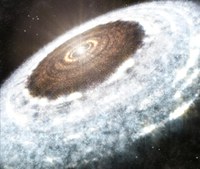
A snow-line is the region of a protoplanetary disk at which a major volatile reaches its condensation temperature. They play a crucial role in disk evolution by promoting the rapid growth of ice-covered grains. Signatures of the carbon monoxide snow-line, at T ~ 20 deg K, have recently been imaged in the disks surrounding the pre-main-sequence stars TW Hydra and HD163296 at distances of ~ 30 AU from the star. But the water snow-line of a protoplanetary disk, at temperatures of more than 100 deg K, has not been seen, as it typically is less than 5 AU from solar-type stars. Water-ice is important because it regulates dust and planetesimal coagulation efficiency, and the formation of comets, ice giants, and the cores of gas giants. Cieza et al. present ALMA images at 0.03 arcsec resolution (12 AU) of the protoplanetary disk around V883 Ori, a 1.3 M⊙ protostar undergoing a luminosity outburst owing to a temporary accretion rate increase. The authors find an intensity break corresponding to an abrupt optical depth change at ~ 42 AU, where the elevated disk temperature approaches water’s condensation point, and conclude that the outburst has moved the water snow-line. The spectral behavior across the snow-line confirms model predictions that dust fragmentation and the inhibition of grain growth at higher temperatures results in soaring grain number densities and optical depths. As most forming planetary systems are expected to experience outbursts caused by accretion, these results imply that highly dynamical water snow-lines must be considered when developing models of disk evolution and planet formation.
Image: Artist impression of the water snowline around the young star V883 Orionis, as observed with ALMA. Credit: A. Angelich (NRAO/AUI/NSF).
Science Team: Lucas A. Cieza (Diego Portales), Simon Casassus, (Univ. de Chile), John Tobin (Leiden), Steven P. Bos, (Leiden), Jonathan P. Williams (Hawaii-Manoa), Sebastian Perez (Univ. de Chile), Zhaohuan Zhu (Princeton), Claudio Caceres (Univ. Valparaiso), Hector Canovas (Univ. Valparaiso), Michael M. Dunham (CfA), Antonio Hales (JAO), Jose L. Prieto (Diego Portales), David A. Principe, (Diego Portales), Matthias R. Schreiber (Valparaiso), Dary Ruiz-Rodriguez (Australian National Univ.), and Alice Zurlo (Diego Portales, Univ. de Chile).
Publication: Imaging the Water Snow-line During a Protostellar Outburst, 2016, Nature, 535, 258.
Spiral Arms Embrace Young Star
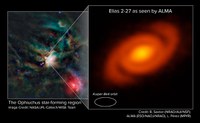 Gravitational forces are expected to excite spiral density waves in protoplanetary disks, the disks of gas and dust orbiting young stars. However, previous observations that showed spiral structure were not able to probe disk midplanes, where most of the mass is concentrated and where planet formation takes place. Using ALMA, Perez et al. have detected a pair of trailing symmetric spiral arms in the protoplanetary disk surrounding the young star Elias 2-27. The arms extend to the disk outer regions and can be traced down to the midplane. These millimeter-wave observations also reveal an emission gap closer to the star than the spiral arms. The authors argue that the observed spirals trace shocks of spiral density waves in the midplane of this young disk.
Gravitational forces are expected to excite spiral density waves in protoplanetary disks, the disks of gas and dust orbiting young stars. However, previous observations that showed spiral structure were not able to probe disk midplanes, where most of the mass is concentrated and where planet formation takes place. Using ALMA, Perez et al. have detected a pair of trailing symmetric spiral arms in the protoplanetary disk surrounding the young star Elias 2-27. The arms extend to the disk outer regions and can be traced down to the midplane. These millimeter-wave observations also reveal an emission gap closer to the star than the spiral arms. The authors argue that the observed spirals trace shocks of spiral density waves in the midplane of this young disk.
Image: ALMA peered into the Ophiuchus star-forming region to study the protoplanetary disk around the young star Elias 2-27. Astronomers discovered a striking spiral pattern in the disk that is the product of density waves – gravitational perturbations in the disk. Credit: L. Pérez (MPIfR), B. Saxton (NRAO/AUI/NSF), ALMA (ESO/NAOJ/NRAO), NASA/JPL Caltech/WISE Team.
Science Team: Laura M. Pérez (MPIfR), John M. Carpenter (JAO), Sean M. Andrews (CfA), Luca Ricci (CfA), Andrea Isella (Rice), Hendrik Linz (MPIfA), Anneila I. Sargent (Caltech), David J. Wilner (CfA), Thomas Henning (MPIfA), Adam T. Deller (ASTRON), Claire J. Chandler (NRAO), Cornelis P. Dullemond (Heidelberg), Joseph Lazio (JPL), Karl M. Menten (MPIfA), Stuartt A. Corder (JAO), Shaye Storm (CfA), Leonardo Testi (ESO, INAF), Marco Tazzari (ESO), Woojin Kwon (KASSI), Nuria Calvet (Michigan), Jane S. Greaves (Cardiff), Robert J. Harris (Illinois), and Lee G. Mundy (Maryland).
Publication: Spiral Density Waves in a Young Protoplanetary Disk, 2016, Science 353, 1519.
The VLA View of the HL Tau Disk
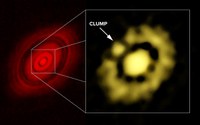 The first long-baseline ALMA campaign resolved the disk around the young star HL Tau into axisymmetric bright and dark rings. Despite the young age of HL Tau, these structures have been interpreted as signatures for the presence of proto-planets. Of special interest are the inner parts of disks, where terrestrial planets are expected to form. However, the emission from these regions in HL Tau are optically thick at ALMA wavelengths, preventing the derivation of surface density profiles and grain size distributions. Carrasco-Gonzalez et al. present the most sensitive images of HL Tau obtained to date with the Karl G. Jansky Very Large Array at 7.0 mm wavelength with a spatial resolution comparable to ALMA. At this wavelength, the dust emission from HL Tau is optically thin, enabling a comprehensive study of the inner disk. The authors obtain a total disk dust mass of 0.001 - 0.003 M⊙. Their VLA data indicate fast grain growth, fragmentation, and formation of dense clumps in the inner, densest parts of the disk. This research suggests that the HL Tau disk may be in a very early stage of formation, with planets not already formed in the gaps but in the process of future formation in the bright rings.
The first long-baseline ALMA campaign resolved the disk around the young star HL Tau into axisymmetric bright and dark rings. Despite the young age of HL Tau, these structures have been interpreted as signatures for the presence of proto-planets. Of special interest are the inner parts of disks, where terrestrial planets are expected to form. However, the emission from these regions in HL Tau are optically thick at ALMA wavelengths, preventing the derivation of surface density profiles and grain size distributions. Carrasco-Gonzalez et al. present the most sensitive images of HL Tau obtained to date with the Karl G. Jansky Very Large Array at 7.0 mm wavelength with a spatial resolution comparable to ALMA. At this wavelength, the dust emission from HL Tau is optically thin, enabling a comprehensive study of the inner disk. The authors obtain a total disk dust mass of 0.001 - 0.003 M⊙. Their VLA data indicate fast grain growth, fragmentation, and formation of dense clumps in the inner, densest parts of the disk. This research suggests that the HL Tau disk may be in a very early stage of formation, with planets not already formed in the gaps but in the process of future formation in the bright rings.
Image: [Left] ALMA image of HL Tau. [Right] VLA image of HL Tau, showing clump of dust. Credit: Carrasco-Gonzalez, et al.; Bill Saxton, NRAO/AUI/NSF.
Science Team: Carlos Carrasco-Gonzalez (UNAM), Thomas Henning (MPIfA), Claire J. Chandler (NRAO), Hendrik Linz (MPIfA), Laura Perez (MPIfA, NRAO, MPIfR), Luis F. Rodriguez (UNAM), Roberto Galvan-Madrid (UNAM), Guillem Anglada (CSIC), Til Birnstiel (MPIfA), Roy van Boekel (MPIfA), Mario Flock (JPL), Hubert Klahr (MPIfA), Enrique Macias (CSIC), Karl Menten (MPIfA), Mayra Osorio (CSIC), Leonardo Testi (ESO, INAF), Jose M. Torrelles (CSIC-IEEC), and Zhaohuan Zhu (Princeton).
Publication: The VLA view of the HL Tau Disk: Disk Mass, Grain Evolution, and Early Planet Formation, 2016, Astrophysical Journal Letters, 821, L16.
Capturing Stellar Fragmentation in Disks
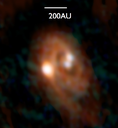 Astronomers believe there are two primary pathways to form binary and multiple star systems: (a) large-scale turbulent fragmentation of cloud cores and filaments; and (b) small-scale fragmentation of a massive protostellar disk due to gravitational instability. While there is evidence for turbulent fragmentation on scales of 1000 AU, evidence for disk fragmentation is limited.
Astronomers believe there are two primary pathways to form binary and multiple star systems: (a) large-scale turbulent fragmentation of cloud cores and filaments; and (b) small-scale fragmentation of a massive protostellar disk due to gravitational instability. While there is evidence for turbulent fragmentation on scales of 1000 AU, evidence for disk fragmentation is limited.
Tobin et al. report on their study of a multiple star system, L1448 IRS3B, which is less than 150,000 years old and includes three stars, all separated by less than 200 AU. ALMA and Jansky VLA observations of the dust and molecular gas in this system reveal a disk with spiral structure surrounding the three protostars. The two protostars near the center of the disk are separated by 61 AU, and a tertiary protostar is coincident with a spiral arm in the outer disk at a separation of 183 AU. The mass of the central pair is 1 M⊙, the disk has a total mass of 0.30 M⊙, and the tertiary protostar has a minimum mass of 0.085 M⊙. The authors demonstrate that the disk around L1448 IRS3B appears susceptible to disk fragmentation at radii between 150 and 320 AU, overlapping with the location of the tertiary protostar, which is consistent with a protostellar disk that recently experienced gravitational instability, yielding one or two stellar companions.
Image: ALMA and Jansky VLA images of the gas and dust in L1448 IRS3B at 1 arcsecond resolution.
Science Team: John J. Tobin (Oklahoma, Leiden), Kaitlin M. Kratter (Arizona), Magnus V. Persson (Leiden, Onsala), Leslie W. Looney (Illinois), Michael M. Dunham (New York–Fredonia), Dominique Segura-Cox (Illinois), Zhi-Yun Li (Virginia), Claire J. Chandler (NRAO), Sarah I. Sadavoy (MPIfA), Robert J. Harris (Illinois), Carl Melis (UC–San Diego), and Laura M. Pérez (MPIfA).
Publication: A Triple Protostar System Formed via Fragmentation of a Gravitationally Unstable Disk, 2016, Nature, 538, 483.
Approaching the Schwarzschild Radius
 Hada et al. report on high-sensitivity, high-resolution 86 GHz observations of the jet base in the radio galaxy M87, obtained by the Very Long Baseline Array in conjunction with the Green Bank Telescope. The resulting image has a dynamic range exceeding 1500 to 1, resolving and imaging a detailed jet structure to ∼10 Schwarzschild radii (Rs). The 86 GHz image confirms important jet features known at lower frequencies, a jet base with a wide opening angle, a limb-brightened intensity profile, a parabola-shape collimation profile, and a counter jet. The limb-brightened structure is already well developed at < 0.2 milli-arcsecond (< 28 Rs, projected) from the core, where the corresponding apparent opening angle becomes as wide as ~ 100 deg. The subsequent jet collimation near the black hole evolves in a complex manner: there is a constricted structure at tens of Rs from the core, where the jet cross section is locally shrinking. The authors suggest that external pressure support from the inner part of the radiatively inefficient accretion flow may be dynamically important in confining the footprint of the magnetized jet. The authors also present the first 86 GHz polarimetric experiment using VLBI for this source.
Hada et al. report on high-sensitivity, high-resolution 86 GHz observations of the jet base in the radio galaxy M87, obtained by the Very Long Baseline Array in conjunction with the Green Bank Telescope. The resulting image has a dynamic range exceeding 1500 to 1, resolving and imaging a detailed jet structure to ∼10 Schwarzschild radii (Rs). The 86 GHz image confirms important jet features known at lower frequencies, a jet base with a wide opening angle, a limb-brightened intensity profile, a parabola-shape collimation profile, and a counter jet. The limb-brightened structure is already well developed at < 0.2 milli-arcsecond (< 28 Rs, projected) from the core, where the corresponding apparent opening angle becomes as wide as ~ 100 deg. The subsequent jet collimation near the black hole evolves in a complex manner: there is a constricted structure at tens of Rs from the core, where the jet cross section is locally shrinking. The authors suggest that external pressure support from the inner part of the radiatively inefficient accretion flow may be dynamically important in confining the footprint of the magnetized jet. The authors also present the first 86 GHz polarimetric experiment using VLBI for this source.
Image: VLBA + GBT 86 GHz false-color total intensity image of the M87 jet. The image is produced by combining the visibility data over the two epochs on 11 & 26 February 2014. The restoring beam is shown in the bottom-right corner. The peak intensity is 500 mJy/beam, the off-source rms noise is 0.28 mJy/beam, where the resulting dynamic range is greater than 1500 to 1.
Science Team: Kazuhiro Hada (NAOJ, INAF), Motoki Kino (KASI), Akihiro Doi (JAEA), Hiroshi Nagai (NAOJ), Mareki Honma (NAOJ, SOKENDAI), Kazunori Akiyama (NAOJ, Tokyo), Fumie Tazaki (NAOJ), Rocco Lico (INAF, Bologna), Marcello Giroletti (INAF), Gabriele Giovannini (INAF, Bologna), Monica Orienti (INAF), and Yoshiaki Hagiwara (NAOJ, Tokyo).
Publication: High-sensitivity 86 GHz (3.5 mm) VLBI Observations of M87: Deep Imaging of the Jet Base at a Resolution of 10 Schwarzschild Radii, 2016, Astrophysical Journal, 817, 131.
Relativistic Jet Physics from MOJAVE
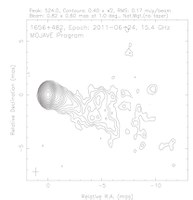 The Monitoring of Jets in Active Galactic Nuclei with VLBA Experiments (MOJAVE) program present 1625 new 15 GHz VLBA images of 295 jets associated with active galactic nuclei (AGNs) from the MOJAVE and 2 cm VLBA surveys. For 274 AGNs with at least 5 VLBA epochs, the authors have analyzed the kinematics of 961 bright features in their parsec-scale jets. In the case of 451 jet features that had at least 10 epochs, they examined their kinematics for possible accelerations. At least half of the well-sampled features have non-radial and/or accelerating trajectories, indicating that non-ballistic motion is common in AGN jets. The distribution of maximum apparent jet speeds in all 295 AGNs measured by MOJAVE is peaked below 5c, with very few jets with apparent speeds >30c. The fastest speed is ~50c and is indicative of a maximum jet Lorentz factor of ~50 in the parent population. An envelope in the maximum jet speed versus redshift distribution of our sample provides additional evidence of this upper limit. The Fermi-Large Area Telescope (LAT)-detected ɣ-ray AGNs have, on average, higher jet speeds than non-LAT-detected AGNs, indicating a strong correlation between parsec-scale jet speed and the ɣ-ray Doppler boosting factor. Of the five gamma-ray loud narrow-lined Seyfert I AGNs in our sample, three show highly superluminal jet motions, while the others have sub-luminal speeds. This indicates that some narrow-lined Seyfert I AGNs possess powerful jets with Lorentz factors consistent with typical BL Lac objects and flat-spectrum radio quasars.
The Monitoring of Jets in Active Galactic Nuclei with VLBA Experiments (MOJAVE) program present 1625 new 15 GHz VLBA images of 295 jets associated with active galactic nuclei (AGNs) from the MOJAVE and 2 cm VLBA surveys. For 274 AGNs with at least 5 VLBA epochs, the authors have analyzed the kinematics of 961 bright features in their parsec-scale jets. In the case of 451 jet features that had at least 10 epochs, they examined their kinematics for possible accelerations. At least half of the well-sampled features have non-radial and/or accelerating trajectories, indicating that non-ballistic motion is common in AGN jets. The distribution of maximum apparent jet speeds in all 295 AGNs measured by MOJAVE is peaked below 5c, with very few jets with apparent speeds >30c. The fastest speed is ~50c and is indicative of a maximum jet Lorentz factor of ~50 in the parent population. An envelope in the maximum jet speed versus redshift distribution of our sample provides additional evidence of this upper limit. The Fermi-Large Area Telescope (LAT)-detected ɣ-ray AGNs have, on average, higher jet speeds than non-LAT-detected AGNs, indicating a strong correlation between parsec-scale jet speed and the ɣ-ray Doppler boosting factor. Of the five gamma-ray loud narrow-lined Seyfert I AGNs in our sample, three show highly superluminal jet motions, while the others have sub-luminal speeds. This indicates that some narrow-lined Seyfert I AGNs possess powerful jets with Lorentz factors consistent with typical BL Lac objects and flat-spectrum radio quasars.
Image: An example of the 1625 naturally-weighted 15 GHz total intensity VLBA contour images of individual epoch observations in the MOJAVE AGN sample.
Science Team: M. L. Lister (Purdue), M. F. Aller (Michigan), H. D. Aller (Michigan), D. C. Homan (Denison), K. I. Kellermann (NRAO), Y. Y. Kovalev (Lebedev, València), A. B. Pushkarev (Lebedev, Crimean Astro. Obs.), J. L. Richards (Purdue), E. Ros (MPIfR, Velancia,), and T. Savolainen (MPIfR, Aalto).
Publication: MOJAVE: XIII. Parsec-scale AGN Jet Kinematics Analysis Based on 19 years of VLBA Observations at 15 GHz, 2016, Astronomical Journal, 152, 12.
A New Era for Cosmological Surveys
 Walter et al. present the rationale for and the observational description of the ALMA SPECtroscopic Survey (ASPECS) in the Hubble Space Telescope Ultra-Deep Field (UDF), the cosmological deep field that has the deepest multi-wavelength data available. The goal is to obtain an unbiased census of molecular gas and dust continuum emission in high-redshift (z > 0.5) galaxies. The ~1 arcminute region covered within the UDF was chosen to overlap with the deepest HST imaging. The observations are full frequency scans in ALMA band 3 (84–115 GHz) and band 6 (212–272 GHz) at approximately uniform line sensitivity (LCO ~ 2 × 109 K km s−1 pc2), and continuum noise levels. The molecular surveys cover the different CO rotational transitions, with essentially full redshift coverage. The [C II] emission line is also covered at redshifts 6.0 < z < 8.0, A customized algorithm identifies line candidates in the molecular line scans and quantifies the ability to recover artificial sources from these data. The most likely line identification is constrained based on whether multiple CO lines are detected, and whether optical spectroscopic redshifts and optical counterparts exist. Ten (Eleven) CO line candidates are found in the 3 mm (1 mm) band, and their statistical analysis shows that < 4 of these in each band are likely spurious. Less than one-third of the total CO flux in the low-J CO line candidates are from sources unassociated with an optical / near-infrared counterpart. The data described in this paper are the basis for multiple dedicated studies presented in subsequent papers.
Walter et al. present the rationale for and the observational description of the ALMA SPECtroscopic Survey (ASPECS) in the Hubble Space Telescope Ultra-Deep Field (UDF), the cosmological deep field that has the deepest multi-wavelength data available. The goal is to obtain an unbiased census of molecular gas and dust continuum emission in high-redshift (z > 0.5) galaxies. The ~1 arcminute region covered within the UDF was chosen to overlap with the deepest HST imaging. The observations are full frequency scans in ALMA band 3 (84–115 GHz) and band 6 (212–272 GHz) at approximately uniform line sensitivity (LCO ~ 2 × 109 K km s−1 pc2), and continuum noise levels. The molecular surveys cover the different CO rotational transitions, with essentially full redshift coverage. The [C II] emission line is also covered at redshifts 6.0 < z < 8.0, A customized algorithm identifies line candidates in the molecular line scans and quantifies the ability to recover artificial sources from these data. The most likely line identification is constrained based on whether multiple CO lines are detected, and whether optical spectroscopic redshifts and optical counterparts exist. Ten (Eleven) CO line candidates are found in the 3 mm (1 mm) band, and their statistical analysis shows that < 4 of these in each band are likely spurious. Less than one-third of the total CO flux in the low-J CO line candidates are from sources unassociated with an optical / near-infrared counterpart. The data described in this paper are the basis for multiple dedicated studies presented in subsequent papers.
Image: The FWHM of the primary beam (areal coverage) of the 3 mm (orange) and 1 mm (cyan) ALMA observations, overlaid on a three-color HST image from the XDF survey (Illingworth et al. 2013). The circles show the ALMA primary beam of each pointing at the central frequencies of the two scans.
Science Team: Fabian Walter (MPIfA, Caltech, NRAO), Roberto Decarli (MPIfA), Manuel Aravena (Diego Portales), Chris Carilli (NRAO, Cambridge), Rychard Bouwens (Leiden), Elisabete da Cunha (Swinburne, Australian National Univ.), Emanuele Daddi (CEA Saclay), R. J. Ivison (ESO, Edinburgh), Dominik Riechers (Cornell), Ian Smail (Durham)), Mark Swinbank (Durham), Axel Weiss (MPIfR), Timo Anguita (Andres Bello, Millennium Inst.), Roberto Assef (Diego Portales), Roland Bacon (Lyon), Franz Bauer (Católica , Millennium Inst., Space Science Inst.), Eric F. Bell (Michigan), Frank Bertoldi (Argelander), Scott Chapman (Dalhousie), Luis Colina (CSIC), Paulo C. Cortes (JAO, NRAO), Pierre Cox (Arizona), Mark Dickinson (Arizona), David Elbaz (CEA Saclay), Jorge Gónzalez-López (Católica), Edo Ibar (Valparaiso), Hanae Inami (Lyon), Leopoldo Infante (Católica), Jacqueline Hodge (Leiden), Alex Karim (Argenlander), Olivier Le Fevre (CNRS), Benjamin Magnelli (Argelandre), Roberto Neri (IRAM), Pascal Oesch (Yale), Kazuaki Ota (Cambridge, Kavli), Gergö Popping (ESO), Hans-Walter Rix (MPIfA), Mark Sargent (Sussex), Kartik Sheth (NASA HQ), Arjen van der Wel (MPIfA), Paul van der Werf (Leiden), and Jeff Wagg (SKA)
Publication: The ALMA Spectroscopic Survey in the Hubble Ultra Deep Field: Survey Description, 2016 Astrophysical Journal, 833, 67.
A Tsunami of Stars & Gas
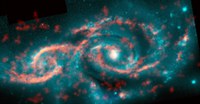 ALMA observations in the 12CO J=1-0 line of the interacting galaxy pair IC 2163 and NGC 2207 at 2 x 1.5 arcsec resolution reveal how the encounter drives gas to pile up in narrow, ~1 kiloparsec wide, "eyelids" in IC 2163. IC 2163 and NGC 2207 are involved in a grazing encounter, which has led to the development in IC 2163 of an eye-shaped (ocular) structure at mid-radius and two tidal arms. The CO data show that there are large velocity gradients across the width of each eyelid, with a mixture of radial and azimuthal streaming of gas at the outer edge of the eyelid relative to its inner edge. The sense of the radial streaming in the eyelids is consistent with the idea that gas from the outer part of IC 2163 flows inward until its radial streaming slows down abruptly and the gas piles up in the eyelids. The radial compression at the eyelids causes an increase in the gas column density by direct radial impact and also leads to a high rate of shear. A linear regression of the molecular column density N(H2) on the magnitude of |dn/dR| across the width of the eyelid at fixed values of azimuth finds a strong correlation between N(H2) and |dn/dR|. Substantial portions of the eyelids have high velocity dispersion in CO, indicative of elevated turbulence there.
ALMA observations in the 12CO J=1-0 line of the interacting galaxy pair IC 2163 and NGC 2207 at 2 x 1.5 arcsec resolution reveal how the encounter drives gas to pile up in narrow, ~1 kiloparsec wide, "eyelids" in IC 2163. IC 2163 and NGC 2207 are involved in a grazing encounter, which has led to the development in IC 2163 of an eye-shaped (ocular) structure at mid-radius and two tidal arms. The CO data show that there are large velocity gradients across the width of each eyelid, with a mixture of radial and azimuthal streaming of gas at the outer edge of the eyelid relative to its inner edge. The sense of the radial streaming in the eyelids is consistent with the idea that gas from the outer part of IC 2163 flows inward until its radial streaming slows down abruptly and the gas piles up in the eyelids. The radial compression at the eyelids causes an increase in the gas column density by direct radial impact and also leads to a high rate of shear. A linear regression of the molecular column density N(H2) on the magnitude of |dn/dR| across the width of the eyelid at fixed values of azimuth finds a strong correlation between N(H2) and |dn/dR|. Substantial portions of the eyelids have high velocity dispersion in CO, indicative of elevated turbulence there.
Image: Dazzling eyelid-like features bursting with stars in galaxy IC 2163 formed from a tsunami of stars and gas triggered by a glancing collision with galaxy NGC 2207 (a portion of its spiral arm is shown on right side of image). ALMA image of carbon monoxide (orange), which revealed motion of the gas in these features, is shown on top of Hubble image (blue) of the galaxy.
Science Team: Michele Kaufman (Newton), Bruce G. Elmegreen (IBM Research), Curtis Struck (Iowa State), Debra Meloy Elmegreen (Vassar), Frédéric Bournaud (CEA Saclay), Elias Brinks (Hertfordshire), Stephanie Juneau (CEA Saclay), and Kartik Sheth (NASA)
Publication: Ocular Shock Front in the Colliding Galaxy IC 2163, 2016, Astrophysical Journal, 831, 161.
New Nanohertz Gravitational Wave Limits
 New upper limits have been computed on the nanohertz-frequency isotropic stochastic gravitational wave background (GWB) using the nine-year data set from the North American Nanohertz Observatory for Gravitational Waves (NANOGrav) collaboration. Well-tested Bayesian techniques set upper limits on the dimensionless strain amplitude for a GWB from supermassive black hole binaries of Agw < 1.5 x 10-15. The Collaboration parameterizes the GWB spectrum with a broken power-law model by placing priors on the strain amplitude derived from simulations of Sesana and McWilliams et al. Using Bayesian model selection, the NANOGrav data favor a broken power law to a pure power law with odds ratios of 2.2 and 22 to one for the Sesana and McWilliams prior models, respectively. Using the broken power-law analysis, posterior distributions are constructed on environmental factors that drive the binary to the gravitational wave-driven regime, including the stellar mass density for stellar-scattering, mass accretion rate for circum-binary disk interaction, and orbital eccentricity for eccentric binaries, marking the first time that the shape of the GWB spectrum has been used to make astrophysical inferences. Returning to a power-law model, stringent limits are placed on the energy density of relic GWs, Ωgw(f)h2 < 4.2 x 10-10. The limit on the cosmic string GWB, Ωgw(f)h2 < 2.2 x 10-10, translates to a conservative limit on the cosmic string tension with Gμ < 3.3 x 10-8, a factor of four better than the joint Planck and high-l cosmic microwave background data from other experiments.
New upper limits have been computed on the nanohertz-frequency isotropic stochastic gravitational wave background (GWB) using the nine-year data set from the North American Nanohertz Observatory for Gravitational Waves (NANOGrav) collaboration. Well-tested Bayesian techniques set upper limits on the dimensionless strain amplitude for a GWB from supermassive black hole binaries of Agw < 1.5 x 10-15. The Collaboration parameterizes the GWB spectrum with a broken power-law model by placing priors on the strain amplitude derived from simulations of Sesana and McWilliams et al. Using Bayesian model selection, the NANOGrav data favor a broken power law to a pure power law with odds ratios of 2.2 and 22 to one for the Sesana and McWilliams prior models, respectively. Using the broken power-law analysis, posterior distributions are constructed on environmental factors that drive the binary to the gravitational wave-driven regime, including the stellar mass density for stellar-scattering, mass accretion rate for circum-binary disk interaction, and orbital eccentricity for eccentric binaries, marking the first time that the shape of the GWB spectrum has been used to make astrophysical inferences. Returning to a power-law model, stringent limits are placed on the energy density of relic GWs, Ωgw(f)h2 < 4.2 x 10-10. The limit on the cosmic string GWB, Ωgw(f)h2 < 2.2 x 10-10, translates to a conservative limit on the cosmic string tension with Gμ < 3.3 x 10-8, a factor of four better than the joint Planck and high-l cosmic microwave background data from other experiments.
Science Team: Z. Arzoumanian (NASA-Goddard), A. Brazier (Cornell), S. Burke-Spolaor (NRAO), S. J. Chamberlin (Penn State), S. Chatterjee (Cornell), B. Christy (Franklin & Marshall), J. M. Cordes (Cornell), N. J. Cornish (Montana State), K. Crowter (British Columbia), P. B. Demorest (NRAO), X. Deng (Penn State), T. Dolch (Cornell, Hillsdale), J. A. Ellis (JPL), R. D. Ferdman (McGill), E. Fonseca (British Columbia), N. Garver-Daniels (West Virginia), M. E. Gonzalez (British Columbia, Vancouver), F. Jenet (Texas-Brownsville), G. Jones (Columbia), M. L. Jones (West Virginia), V. M. Kaspi (McGill), M. Koop (Penn State), M. T. Lam (Cornell), T. J. W. Lazio (JPL), L. Levin (West Virginia), A. N. Lommen (Franklin & Marshall), D. R. Lorimer (West Virginia), J. Luo (Texas-Brownsville), R. S. Lynch (NRAO), D. R. Madison (Cornell, NRAO), M. A. McLaughlin (West Virginia), S. T. McWilliams (West Virginia), C. M. F. Mingarelli (TAPIR, MPIfR), D. J. Nice (Lafayette), N. Palliyaguru (West Virginia), T. T. Pennucci (Virginia), S. M. Ransom (NRAO), L. Sampson (Montana State), S. A. Sanidas (Amsterdam, Jodrell Bank), A. Sesana (Birmingham), X. Siemens (Wisconsin-Milwaukee), J. Simon (Wisconsin-Milwaukee), I. H. Stairs (British Columbia), D. R. Stinebring (Oberlin), K. Stovall (New Mexico), J. Swiggum (West Virginia), S. R. Taylor (JPL), M. Vallisneri (JPL), R. van Haasteren (JPL), Y. Wang (Huazhong), and W. W. Zhu (British Columbia, MPIfR).
Publication: The NANOGrav Nine-Year Data Set: Limits on the Isotropic Stochastic Gravitational Wave Background, 2016 Astrophysical Journal, 821, 13.
Earth–space interferometry with RadioAstron
 Earth–space interferometry with RadioAstron provides the highest direct angular resolution ever achieved in astronomy at any wavelength. RadioAstron detections of the classic quasar 3C 273 on interferometric baselines up to 171,000 km suggest brightness temperatures exceeding expected limits from the inverse-Compton catastrophe by two orders-of-magnitude. The authors show that at 18 cm, these estimates most likely arise from refractive substructure introduced by scattering in the interstellar medium. They use the scattering properties to estimate an intrinsic brightness temperature of 7 x 1012 K, which is consistent with expected theoretical limits, but which is ~15x lower than estimates that neglect substructure. At 6.2 cm, the substructure influences the measured values appreciably but gives an estimated brightness temperature that is comparable to models that do not account for the substructure. At 1.35 cm, the substructure does not affect the extremely high inferred brightness temperatures, in excess of 1013 K. The authors also demonstrate that for a source having a Gaussian surface brightness profile, a single long-baseline estimate of refractive substructure determines an absolute minimum brightness temperature, if the scattering properties along a given line of sight are known, and that this minimum accurately approximates the apparent brightness temperature over a wide range of total flux densities.
Earth–space interferometry with RadioAstron provides the highest direct angular resolution ever achieved in astronomy at any wavelength. RadioAstron detections of the classic quasar 3C 273 on interferometric baselines up to 171,000 km suggest brightness temperatures exceeding expected limits from the inverse-Compton catastrophe by two orders-of-magnitude. The authors show that at 18 cm, these estimates most likely arise from refractive substructure introduced by scattering in the interstellar medium. They use the scattering properties to estimate an intrinsic brightness temperature of 7 x 1012 K, which is consistent with expected theoretical limits, but which is ~15x lower than estimates that neglect substructure. At 6.2 cm, the substructure influences the measured values appreciably but gives an estimated brightness temperature that is comparable to models that do not account for the substructure. At 1.35 cm, the substructure does not affect the extremely high inferred brightness temperatures, in excess of 1013 K. The authors also demonstrate that for a source having a Gaussian surface brightness profile, a single long-baseline estimate of refractive substructure determines an absolute minimum brightness temperature, if the scattering properties along a given line of sight are known, and that this minimum accurately approximates the apparent brightness temperature over a wide range of total flux densities.
Image: Artist rendering of the orbiting RadioAstron satellite, the farthest element in an array of radio antennas that combine to form the highest resolution instrument in all of astronomy. Credit: Lavochkin Association.
Science Team: Michael D. Johnson (CfA), Yuri Y. Kovalev (Lebedev, MPIfR), Carl R. Gwinn (UC-Santa Barbara), Leonid I. Gurvits (VLBI ERIC, Delft), Ramesh Narayan (CfA), Jean-Pierre Macquart (ICRAR, CAASTRO), David L. Jauncey (CSIRO, ANU), Peter A. Voitsik (Lebedev), James M. Anderson (Helmholtz-Zentrum), Kirill V. Sokolovsky (Lebedev, Moscow State), and Mikhail M. Lisakov (Lebedev).
Publication: Extreme Brightness Temperatures and Refractive Substructure in 3C273 with RadioAstron, 2016, Astrophysical Journal Letters, 820, L10.
Life’s First Handshake: Chiral Molecule Detected
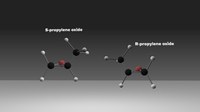 Life on Earth relies on chiral molecules – species that are not superimposable on their mirror images. This manifests itself in the selection of a single molecular handedness, or homochirality, across the biosphere. The authors present the astronomical detection of a chiral molecule, propylene oxide (CH3CHCH2O), in absorption toward the Galactic Center, the first complex organic chiral molecule detected in interstellar space. The research was undertaken primarily with the Green Bank Telescope (GBT) as part of the Prebiotic Interstellar Molecular Survey. Additional supporting observations were taken with the Parkes radio telescope in Australia. Propylene oxide was detected in the gas phase in a cold, extended molecular shell around the embedded, massive protostellar clusters in the Sagittarius B2 star-forming region. Complex organic molecules form in interstellar clouds like Sagittarius B2 in several ways. The most basic pathway is through gas-phase chemistry, in which particles collide and merge to produce ever more complex molecules. Once organic compounds as large as methanol (CH3OH) are produced, however, this process becomes much less efficient. To form more complex molecules, such as propylene oxide, astronomers believe thin mantles of ice on dust grains help link small molecules into longer and larger structures. These molecules can then evaporate from the surface of the grains and further react in the gas of the surrounding cloud.
Life on Earth relies on chiral molecules – species that are not superimposable on their mirror images. This manifests itself in the selection of a single molecular handedness, or homochirality, across the biosphere. The authors present the astronomical detection of a chiral molecule, propylene oxide (CH3CHCH2O), in absorption toward the Galactic Center, the first complex organic chiral molecule detected in interstellar space. The research was undertaken primarily with the Green Bank Telescope (GBT) as part of the Prebiotic Interstellar Molecular Survey. Additional supporting observations were taken with the Parkes radio telescope in Australia. Propylene oxide was detected in the gas phase in a cold, extended molecular shell around the embedded, massive protostellar clusters in the Sagittarius B2 star-forming region. Complex organic molecules form in interstellar clouds like Sagittarius B2 in several ways. The most basic pathway is through gas-phase chemistry, in which particles collide and merge to produce ever more complex molecules. Once organic compounds as large as methanol (CH3OH) are produced, however, this process becomes much less efficient. To form more complex molecules, such as propylene oxide, astronomers believe thin mantles of ice on dust grains help link small molecules into longer and larger structures. These molecules can then evaporate from the surface of the grains and further react in the gas of the surrounding cloud.
Image: The S (Latin for sinister, left) and R (Latin for rectus, right) versions of the chiral molecule propylene oxide, which was discovered in a massive star-forming region near the center of our Galaxy. This is the first detection of a chiral molecule in interstellar space. Credit: B. Saxton (NRAO/AUI/NSF)
Science Team: Brett A. McGuire (NRAO, Caltech), P. Brandon Carroll (Caltech), Ryan A. Loomis (Harvard), Ian A. Finneran (Caltech), Philip R. Jewell (NRAO), Anthony J. Remijan (NRAO), and Geoffrey A. Blake (Caltech).
Publication: Discovery of the interstellar chiral molecule propylene oxide (CH3CHCH2O), 2016 Science, 352, 1449.




Connect with NRAO